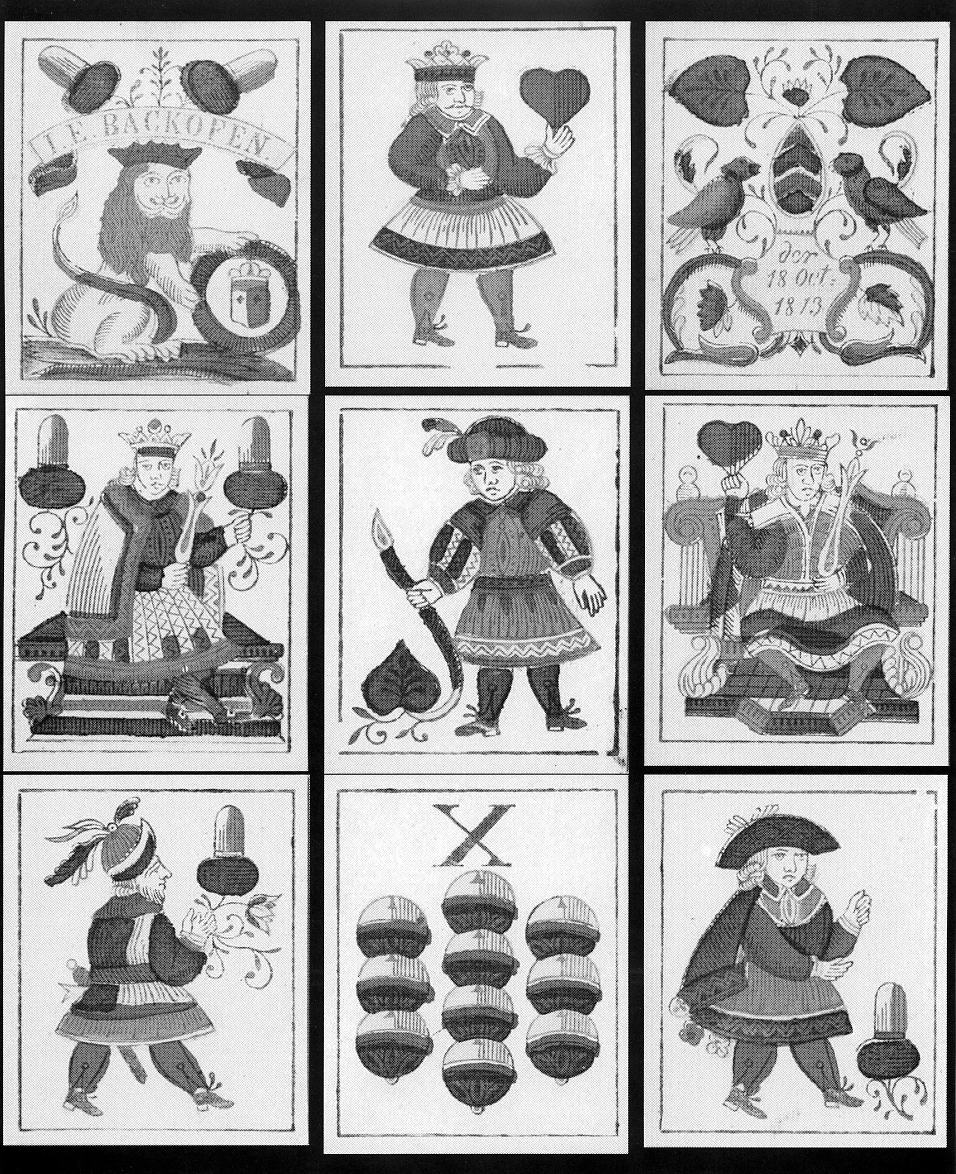

| Suit System: | G |
| Recommended Name: | Nürnberg pattern wide cards (Breite Karte). |
Other names: "Nürnberger Karte" (Bierdimpfl), "Nürnberger deutsche Karte", "Nürnberger Typus" (Essenwein, Schreiber). In the literature the pattern is often called Ansbach pattern. This pattern sheet, together with [IPCS #88], replaces the G5 pattern sheet, published previously.
The Nürnberg pattern is one of the oldest and most established German patterns. Its ancestors can be traced to the "Merkle pattern" made c.1520 by Bernhard Merkle in Nürnberg. The pattern was probably already established in Nürnberg by around 1500 (Hoffmann, Essenwein). During the 17th century it was already being produced from Würzburg to Regensburg; in the 18th century it was printed by Joseph Henseler in Kempten (Cary Coll. GER171), and by 1800 it was being produced in Graz in Austria, although with regional deuces (Reisinger). From around 1820 the inscription "den 18. Oct. 1813" on the Deuce of Leaves refers to the battle against Napoleon near Leipzig. In the second half of the 19th century the wide cards are replaced by a narrow version [IPCS #88].
The name Ansbach pattern which is often used is misleading; it is due to the fact that this pattern ended up being used only in its narrow form [IPCS #88] in the Ansbach region. There it was used by older players, but only for certain games. Schafkopf was already being played with the Bavarian and Franconian patterns [IPCS #83].
Besides the unusual wide format of the cards, the primary characteristic of this pattern (also maintained in the narrow variant) are the suit signs on the court cards: except for the King of Acorns all Kings, Obers and Unters have only one suit-sign. The King of Acorns has two suit-signs!
In 36-card packs, the Six of Hearts shows the Nürnberg coat-of-arms: the Noris, personification of Nürnberg, holding two escutcheons, with the Imperial eagle on one of them, and the small Nürnberg coat-of-arms on the other. The Obers and Unters do not carry arms.
32 or 36 cards: Deuce, King, Ober, Unter, and numerals 10 (X) to 7 (6).
Bernhard Merkle, Johann Basilius Bleyl, Rudolph Martin Schenck, Backofen, Haupold, Reuter, Jegel, all from Nürnberg;
Christian Friedrich Schenck, Regensburg;
Arnold, Neuburg;
Schaller, Würzburg;
Christoph Fleischer, Ansbach;
Joseph Henseler, Kempten;
Leopold Milchram, Graz.
Essenwein: Katalog der im Germanischen Museum befindlichen Kartenspiele und Spielkarten, Nürnberg 1886
Bierdimpfl: Die Sammlung der Spielkarten des baierischen Nationalmuseums, München 1884
Hoffmann: Altdeutsche Spielkarten 1500 - 1650, Nürnberg 1993
Hausler: Ansbacher Bild oder doch Nürnberger Bild? in: Das Blatt Nr.25, Berlin 2002
Radau/Matthes: Deutsche Spielkarten 1650 - 1900, Nürnberg 2001
Reisinger: Herz-Schelle-Laub-Eichel, Spielkarten mit Deutschen Farben, Wien 2004
Keller: The Cary Collection of Playing Cards, New Haven 1981
Schreiber: Die ältesten Spielkarten, Straßburg 1937

| Johann Ernst Backofen c.1820; from the collection Hausler. |
| The International Playing-Card Society | 3/2007 MH |